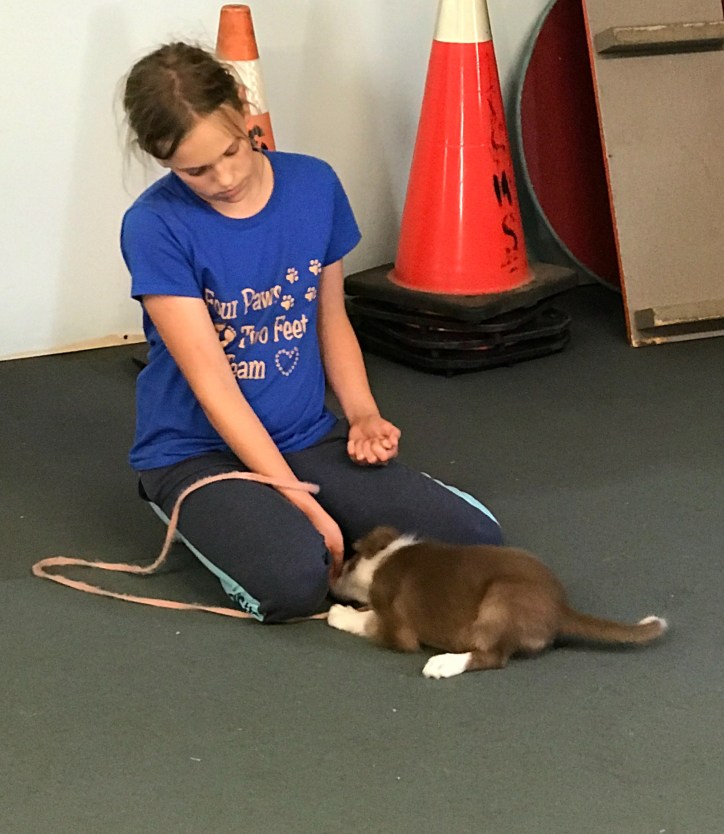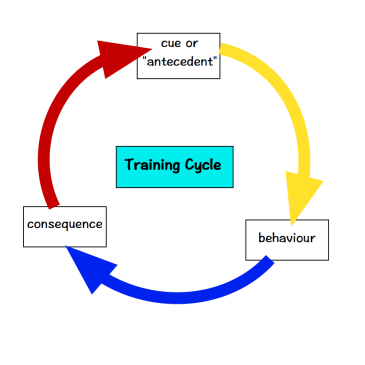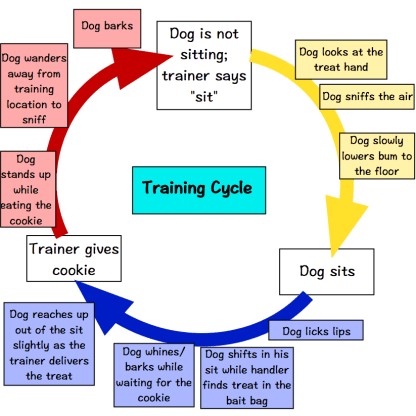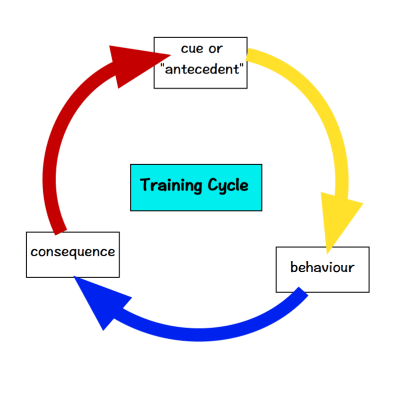Alright, this is my final installment on loopy training training, at least for now… For this post I’m focusing on the yellow arrow in the training loop.

I’ve left this one for last, because I think that it is probably the most obvious for many people that what the dog does between the cue and finished execution of the behaviour is rewarded by the cookie. Let’s take a look at the more specific example of sit to see some places where this can trip up our training plan.

In above picture of the training loop, I’ve stuck to examples of things that might happen after you give your verbal cue to sit. Shifting their eye focus, sniffing the air and a slow execution are all things that you might see. If these behaviours are followed by a cookie, then they are rewarded by the cookie because they fall inside the bigger training loop.
The yellow arrow gets more interesting when you realize that the antecedentor cue is so much more than the word you say. In fact, it may be a bit hard to tease out where the antecedent starts… Does it begin when you unclip your dog’s leash to begin the exercise? Or maybe when you step into the training building or arena? How about when you get into the car? Start packing your training bag? Cutting up the treats on the counter? What about when you put on your dog training clothing? What about cutting up the treats on the counter at home? Dogs are great predictors. Most people report that their dogs know they are heading to training class long before they are even in the car. But that is food for another post someday as we jump into the rabbit hole of training loops inside training loops…
For now, let’s just focus on ways we can reduce “garbage” in the yellow arrow. Here are 4.
- Give a non-contingent reward before you begin. A non-contingent cookie means that the dog didn’t have to do a specific behaviour to earn. If your dog has been on its bed or in its crate for a few minutes before beginning, it is possible that there is some built up frustration or anticipation for the rewards. Giving the dog a non-contingent reward helps us to start our current session with positive emotions. Giving the dog a cookie as you open the crate or clip on/off the leash, may not be exactly “non-contingent” but I think it is close enough for this to pay off.
- Begin each training session with some offered behaviour. Offered behaviours are things your dog will do without a specific verbal or physical cue such as give eye contact, sit, lie down, or take heel position. Of course, as mentioned above, there are cues in the environment and the setup telling them what offered behaviours are likely to pay off, but if there is no specific cue, you avoid the risk of the “garbage” in the yellow arrow getting attached to your precious cue word. Offered behaviours also serve as a bit of a thermometer telling you if your
- Start with easier behaviours. Beginning with easier behaviours your dog knows well can help you build up something trainers are calling Behavioural Momentum, which looks like a work flow. Think of it as getting the behaviour juices flowing before moving on to something more complex. This will hopefully reduce latency, the time between the cue and the behaviour” shortening up the yellow arrow and leaving less time for “garbage” to creep in.
- Consider more shaping. If you aren’t getting quick execution of the behaviour to your cue, think about dropping out the cue and going back a step to help make the behaviour cleaner and faster before adding back in your cue. If that doesn’t help, you may have to do it again, but this time change your chosen cue. Perhaps the cue you selected is too similar to another cue and it is causing some confusion in your learner, or perhaps you have already poisoned your desired cue somewhat by linking it to some garbage behaviour you don’t want.
I’m sure there are many more options out there to tighten up the yellow arrow. Perhaps you can share some of your own ideas. Happy Training!







